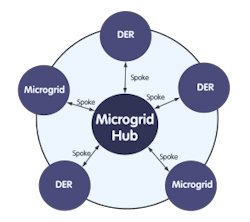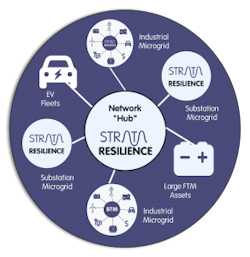Tim McDuffie, senior business development engineer at Smarter Grid Solutions, explains why different microgrid implementations require different controllers.
When people think about microgrids, they often envision a microgrid in a box scenario where one or two energy sources such as a battery and solar panels are connected to a basic microgrid controller. This could be the perfect set up for a small business like a bank or a library where the controller handles straightforward functions like managing islanding or dispatch scheduling. This plug and play scenario can save customers on their electricity costs and provide resilience in case of a grid outage.
But microgrids are not one-size-fits-all and neither are microgrid controllers. A different approach must be taken with larger, more complex microgrids that tie multiple energy sources or multiple microgrids together via a centralized hub.
The Hub and Spoke Approach
For complex microgrids with multiple distributed energy resources (DERs), a hub and spoke approach is best (Figure A). This style of microgrid design merges the benefits of redundant, on-site controls with a “system of systems” approach, allowing for system-wide optimization and control. It’s highly scalable – customers can add complexity over time in the form of other DERs – and very flexible because the DERs can function independently or as a part of the larger microgrid.
Figure A: Hub and spoke design for complex microgrids. Source: Smarter Grid Solutions
Of course, as the complexity of the microgrid grows, the capabilities of the controller must also grow. The basic controller in a typical microgrid in a box system won’t support the demands of a more complex microgrid. For that, you need a more robust controller capable of balancing the various energy resources and delivering resilience, managing forecasting, optimizing the system and scaling with it over time.
To demonstrate why the complexity of your microgrid design should dictate the capabilities of the controller, let’s look at three large-scale microgrid use cases, each one growing in terms of scope and complexity.
Industrial Microgrid
Industrial microgrids, the first tier of complex microgrids we’ll look at, can be used by cold storage, agricultural, and manufacturing facilities. Often, these microgrids look like their own mini distribution system. Due to the number of DERs feeding into them, they require more thought, planning and design than can be delivered with the typical microgrid in a box solution.
Figure B: Industrial microgrid design. Source: Smarter Grid Solutions
As illustrated in Figure B, the controller in an industrial microgrid needs to be able to balance, forecast, and optimize energy coming from the grid, on-site renewables and battery energy storage systems, generators, and perhaps even the organization’s fleet of electric vehicles. Switchgear integration means an industrial microgrid can automatically transition between grid and island mode.
Community and Substation Microgrids
In the second tier, we find community microgrids like those being promoted by California’s new microgrid incentive program. Typically managed from a substation (and sometimes called substation microgrids), these larger projects can include multiple industrial microgrids as well as behind-the-meter (BTM) sites and front-of-the-meter (FTM) assets, as highlighted in Figure C. As the name implies, a community microgrid can support homes, businesses and critical infrastructure in a defined area.
Figure C: Community and substation microgrid design. Source: Smarter Grid Solutions
In this scenario, the controller balances, forecasts, and optimizes connected DERs just like with an industrial microgrid, but at a larger scale. It also must integrate bi-directional energy with new or existing DERs and utility SCADA systems, enable black starts, prioritize loads and support real time automation and control.
Networked Microgrid
The third tier, networked microgrids, are the most complex, large-scale design scenario you’re likely to encounter today. Networked microgrids have similar features to community microgrids but are done on a much larger scale. You can think of them as a grid of microgrids.
Figure D: Networked microgrid design. Source: Smarter Grid Solutions
Often deployed on islands or in remote locations to provide grid services to a local utility, networked microgrids tie multiple industrial microgrids, multiple community / substation microgrids, large FTM assets and even EV fleets together via a central hub (Figure D). Each component of a networked microgrid can work together to support the entire ecosystem or be isolated to function on its own.
The centralized controller used in this application must be able to manage the entire DER Management System (DERMS) ecosystem, typically using real time automation with other look-ahead operations scheduling functionality. That means optimizing multiple microgrids or large DER assets to achieve carbon reduction, financial optimization, and renewable energy optimization. The controller must also integrate with any advanced distribution management systems (ADMS), manage constraints and preventing nuisance tripping of protective devices.
Final Thoughts
The controller is one of the most important components of a microgrid. If you’re just looking to support a single small business with a microgrid, a simple controller and a microgrid in a box will serve you well. But, if you need a larger scale, complex microgrid, that may grow over time then make sure you have a flexible microgrid controller that is capable of optimizing your DERs and maximizing the returns of your system.
Tim McDuffie is senior business development engineer at Smarter Grid Solutions.




